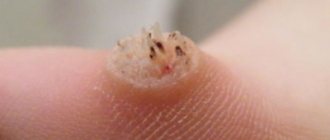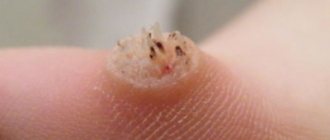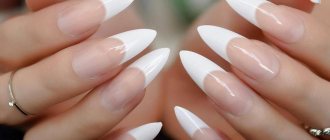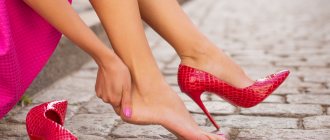How to remove subungual callus?
A callus under the nail is a rather unpleasant pathological process that occurs when shoes are worn incorrectly. When a callus appears, a person experiences not only inconvenience, but also pain.
What it is?
A callus is an area with keratinized epithelium that has been layered for a long time and does not peel off.
The problem can appear anywhere near the nail and cause discomfort when walking. This applies to a greater extent to women; they often develop this pathology. It is characterized by dense epidermal tissue in the distal part of the finger. The formation can appear anywhere on the nail. Once formed, it causes pain when walking and putting on shoes.
In what cases should you urgently consult a doctor?
Without proper treatment, the callus will impair walking. The pathological process will go deeper into the tissue, and infection may occur. The callus under the toenail may not be isolated.
Contact a specialist immediately in the following cases:
- The affected area is very red and swollen.
- A wound has formed from which blood is oozing.
- The callus causes pain when walking.
- Suppuration develops.
- There is unusually intense nail growth.
Pay attention to disinfection of tools before you start using them. Manicure manipulations are common routes of transmission of dangerous viral diseases: hepatitis, HIV, etc.
How does it appear on the thumb and other fingers?
The formation of a callus begins with the appearance of a small bubble , which everyone knows about when putting new shoes on their feet. If you do not pay attention to the pain and continue to wear such shoes, then active layering of the epithelium will begin, which occurs in several stages.
Reference . At first there is a slight pain. Changing shoes and using special creams can solve the problem. But if measures are not taken, the situation will worsen, and the epithelium will deepen into the lower layers. Severe pain and bleeding are reasons to consult a specialist.
In addition to uncomfortable shoes, the following phenomena can affect the formation of calluses:
- A foot deformity that causes the bunion in the big toe to protrude. This may be a hereditary pathology or acquired.
- Poor hygiene. The nail plate may be very short, which causes rubbing of the soft tissues.
- Fungal infections of the nails can lead to deformation.
Improper nail care is the main reason for the development of keratinization . The stratum corneum of the epidermis thickens due to increased pressure. The nail itself can compress the soft tissue. This happens due to improper trimming of its edges.
Regardless of the reasons for the formation of a callus, when it appears, it is necessary to exclude the provoking factor and begin treatment.
Reasons for appearance
The most common places for calluses are the thumb and little finger. The phenomenon has the following reasons:
- Genetic predisposition or acquired change in the foot. It appears as a rounded bone.
- Inadequate nail length.
- Inconvenient shoes: ill-fitting, tight, made from low-quality fabric.
Let us consider in detail each of the provoking factors.
Wrong shoes
Specific hygiene requirements apply to shoes and boots that are used daily. Shoes perform a protective function, protecting limbs from adverse environmental factors. It is very important that it is of high quality, made of special materials, and matches the anatomical shape of a particular person’s foot.
Primary requirements:
- optimal material;
- lightness, comfort when wearing;
- anatomically shaped insole;
- water-repellent properties;
- unchanged shape after moistening and drying;
- The inner surface should not stain the skin of the feet when worn.
When purchasing, pay attention to the size. By choosing something that is not yours (for the sake of beauty), you risk earning many problems, and a callus is not the worst of them.
Incorrect nail length
Too long a nail interferes with movement, clings to the toes, and becomes rough at the end. In addition, during the cold season, the nail plate of the lower extremities suffers from a lack of vitamins and microelements, which worsens its appearance and can cause various diseases.
Trimming to the very root is one of the extremes in the issue of regulating the length of the nail. In addition to painful sensations, delicate skin left without protection will quickly become covered with a hard callus, and the sharp edges will rub neighboring fingers. The nail may begin to grow into neighboring tissues. This phenomenon is especially typical for the thumb and little finger.
Foot deformity
It can be congenital, acquired or a consequence of birth pathologies. When parents buy beautiful, but low-quality shoes for their children, they run the risk of discovering curvature of the distal parts of the foot. The toes fall behind each other and converge at a pathological angle.
This picture opens up the possibility of scratching the skin with a nail, indentation, and ingrowth.
How to get rid of it: treatment options
At the initial stage of callus formation, you can cope with the problem yourself, or you can turn to specialists.
Reference . At home, subungual callus should be treated only at the initial stage of its development, and only specialists can deal with advanced cases.
What can you do at home?
At home, treatment is exclusively symptomatic and helps only in the initial stages. Before starting any therapy, it is necessary to minimize the negative effects of provoking factors. If the reason is wearing uncomfortable shoes, then you should refuse them. This is necessary to prevent the patient's condition from worsening. Then you can begin the therapy itself.
The following are effective methods:
- Herbal baths. A collection of anti-inflammatory herbs such as linden, calendula, chamomile are mixed with baking soda. Next, pour boiling water over the resulting mixture, and when the optimal temperature is reached, dip your feet in it. It is necessary to keep your feet in the water until it cools down.
- Moisturizing creams will help soften the nail plate and relieve pain.
- If the callus spreads beyond the nail plate, you can adjust its shape with pumice. This will reduce the pressure inside and reduce pain.
- Dissolve 1 tablespoon of salt in 1 liter of warm water. Place your foot in the bath for thirty minutes. It will help eliminate pain, burning and swelling in the finger. After the procedure, the skin should be moisturized with cream.
- Add the juice of one lemon to three liters of hot water. Place your foot in the bath for thirty minutes. After the procedure, additional lemon juice is applied to the nail and lubricated with moisturizer.
Important! The use of any folk remedies in the treatment of calluses must be agreed upon with a doctor.
By medicinal methods
Collomak gel is considered a popular medicine. It is used to treat foot fungus, but also shows good results when removing subungual callus. To do this, you need to put the gel in the subungual space a couple of times a day. Thanks to the exfoliating effect of salicylic acid, rapid relief is achieved, and the formation itself becomes smaller in size.
Surgical removal
If, after home and drug therapy, the callus does not go away, the pain does not disappear, but only intensifies, then only a medical professional or a good pedicurist and manicurist can help.
Therapy in this case is quite complicated, but this is the only sure way to permanently get rid of the keratinized area that causes discomfort. You should not try to remove the callus yourself .
The vessels in the nail area are close to the surface, and one wrong move will cause severe bleeding and damage the nail. And unsterile instruments will lead to the development of infection.
Subungual callus is removed in several approaches:
- First, the doctor determines the size of the formation, then makes a small hole on the surface using a special tool.
- Using a small drill, the specialist pierces the affected area of skin until the patient experiences mild pain.
- A substance is injected into the hole, completely corroding the callus.
- After the tissue has healed, the specialist performs a nail prosthesis. Using acrylic or gel, its integrity is recreated.
The procedure is quite painful, so it is performed under local anesthesia. If the formation appears again, then a repeat visit to the hospital is inevitable. If the cause of the tumor is not shoes, but a foot deformity, then the doctor prescribes surgery to remove the bone.
Today there are many ways to get rid of subungual callus. For this, doctors use a diamond bur. During this procedure, it is not necessary to remove the nail. It is enough to lift the plate and drill out the resulting callus with a tool.
Preparations against formations under the nail
There are various drops and ointments, as well as patches soaked in special solutions that help remove the formation. They contain acids or other components that dissolve keratinized tissue, soften it, thereby facilitating further removal of the formation.
The most common means, besides Collomak, include:
- "Solcoderm";
- "Doufilm";
- salicylic ointment;
- "Salipod" patch.
To eliminate negative consequences, consultation with a specialist is recommended. It is better to prevent any disease than to treat it.
There are many effective ways to remove calluses, but it is better to prevent pathology.
- Wear only comfortable shoes that meet hygienic requirements. There is no need to save on your health. Buying the wrong shoe size just in pursuit of beauty is a dangerous decision.
- Use moisturizing foot cream. It nourishes the tissues and prevents them from becoming rough.
- Several times a week you need to use devices to exfoliate excess keratin from the surface of the skin of the feet.
- Soft silicone pads provide additional cushioning and help prevent excessive contact between your fingers.
Medicine today can easily deal with calluses. There is no need to start the process; you should treat yourself or consult a doctor. Particular attention should be paid to the selection of shoes, as they play a key role in the issue of skin damage to the limbs.
What is the difference between a medical pedicure and a classic one?
Classic pedicure is a hardware method of tidying up the foot while removing the stratum corneum. For severe problems, not only aesthetics are required, but also the therapeutic nature of the procedure:
- chronic or single ingrown nails;
- hyperkeratosis;
- core calluses with a complex structure affecting the deep layers of the dermis;
- deep cracks;
- increased sweating of the feet;
- injury or deformation of the nail plate;
- deformation of fingers;
- ulcers in diabetes;
- onychomycosis.
All diseases have a complex pathogenesis and require an integrated approach to treatment. Before starting the procedures, it is recommended to make sure that the specialist is qualified: only a podiatrist – a doctor with a specialized education – can offer medical pedicure services.
Pedicure features:
- aimed at treating the disease, and not at cosmetically masking the problem;
- a variety of cutters are used, which differ in the shape and grain size of the abrasive surface;
- bloodless and safe elimination of most foot problems;
- You can correct the direction of growth of the nail plate with special staples and plates;
- removal of the roots of warts, calluses, papillomas is performed;
- hardware procedures take place without damaging the skin, which is important for older people and patients with diabetes;
- blood circulation in the legs improves.
The qualifications of a podiatrist make it possible to treat a wide range of foot diseases and diagnose pathologies that will subsequently require the intervention of highly specialized doctors.









